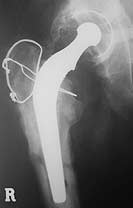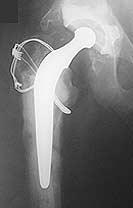One-stage revision THR for deep infection safe and effective
After 12 years, the infection free rate was 85.2% and implant survival was 79.6% with one-stage revision.
WRIGHTINGTON, England — A new study may change surgeons’ minds about the safety and efficacy of one-stage revision total hip replacement for deep infection.
 --- This image
shows a 59-year-old man with a total hip replacement infected with E. Coli.
Note the discharging sinus as well as the cloaca in the femur.
--- This image
shows a 59-year-old man with a total hip replacement infected with E. Coli.
Note the discharging sinus as well as the cloaca in the femur.
COURTESYOF HAJIME NAGAI
Although many surgeons feel that two-stage revision total hip replacement (THR) for deep infection is safer and more effective than one-stage revision, very few long-term studies support this belief. The variety of patient selection protocols, timing of surgeries, surgical techniques, antibiotic protocols and definitions of success and failure and follow-up periods in the literature make it difficult to compare one-stage revision and two-stage revision directly. Surgeons, therefore, have little information upon which to base their clinical decision-making.
“Because the incidence of deep infection rate in THR is relatively low, few surgeons have sufficient opportunities to gather practical experience with the management or achieve long term follow-up results,” said co-investigator Hajime Nagai, MD.
Over the long term
A group of orthopaedic surgeons from the John Charnley Research Institute at Wrightington Hospital, here, recently evaluated the long-term efficacy of one-stage revision THR for deep infection among 162 revisions performed between 1974 and 2001. They presented their results at the American Academy of Orthopaedic Surgeons 70th Annual Meeting in New Orleans.
 --- A one-stage
revision total hip replacement with antibiotic-loaded cement.
--- A one-stage
revision total hip replacement with antibiotic-loaded cement.
COURTESYOF HAJIME NAGAI
The study included 162 revisions in 154 patients: 150 had primary THA, seven had at least one prior revision and five had an infected hemi-arthroplasty. Average age at the time of surgery was 63 years. The mean duration of follow-up was 12.3 years.
Surgeons performed trochanteric osteotomy for extensive resection of infected tissue and cement removal. Antibiotic-loaded cement was used in 152 cases (93.8%). Systemic antibiotics were prescribed from six to 12 weeks postoperatively based on specimens obtained during surgery.
“In the operative technique, we followed strict protocol. This included full exposure, removal of component and all acrylic cement, excision of pyogenic granulation tissue, synovium and capsule, thorough preparation of the bony bed, systemic antibiotics, local antiseptics, use of antibiotic containing acrylic cement, sound fixation of components, bed rest, continuation of antibiotic medication,” Nagai said.
The researchers defined failure of infection control as reoperation for recurrent infection or clinically persistent infection. Mechanical failure was defined as reoperation for mechanical reasons such as aseptic loosening or dislocation or radiologic loosening.
Approximately 32% of the patients (n=52) had discharging sinus at the time of revision THR, while nearly 63% (n=102) had no history of discharging sinus. Discharging sinus was not considered a risk factor for infection control following one-stage revision THR.
Positive data
|
At latest follow-up, 138 hips (85.2%) were free of infection, 11 hips were converted to pseudoarthrosis and nine were re-revised for persistent or recurrent infection. Four hips maintained their implants with evidence of infection. The success rate among the cases without discharging sinus was 82.7%, while the success rate reached 90.4% in the subjects with discharging sinus.
The researchers noted that in two-stage revision for deep infection, only cases that have achieved adequate infection control progressed to reimplantation. In one-stage revision, by comparison, the only condition for reimplantation is that there is sufficient bone stock to fix implants. Given the high success rates and long-term follow-up of this study, they concluded that one-stage revision was effective for deep infection following THR.
The principles employed in this study are valid for management of sepsis in general, with physical elimination of infected and foreign material, closure of cavities, stabilization of limb, rest and antibiotics,” Nagai said.
For your information:
- Nagai H, Wroblweski B, Gambhir A, et al. One-stage revision total hip replacement for deep infection: 5- to 27-year follow-up study. #99. Presented at the American Academy of Orthopaedic Surgeons 70th Annual Meeting. Feb. 5-9, 2003. New Orleans.
